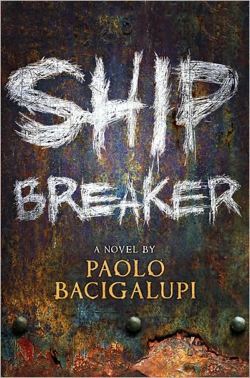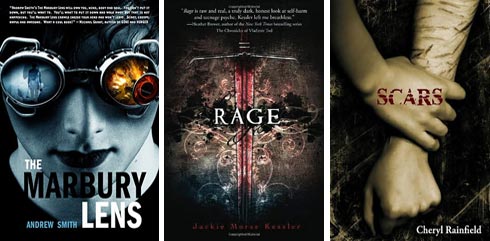Every year or so, there appears a much-publicized article decrying the dark, depressing and degenerate state of young adult fiction. The most recent edition of this perennial kerfuffle broke out last Saturday, when the Wall Street Journal published a piece by one Meghan Cox Gurdon entitled “Darkness Too Visible,” which hit all the traditional high points: the hapless anecdotal parent who can’t find a decent book for her child; the alarmist list of topics supposedly now common in YA (“kidnapping and pederasty and incest and brutal beatings are now just part of the run of things in novels directed at children from the ages of 12 to 18.”); the castigation of publishers as money-grubbing opportunists who don’t care a fig for children’s fragile sensibilities.

In response, the kid/teen literature community sprang to its collective keyboard and unleashed a flood of online and print rebuttals; there’s a good roundup of some of them at the “A Chair, a Fireplace and a Tea Cosy” blog. YA author Maureen Johnson launched the Twitter hashtag #yasaves, which prompted over 30,000 tweets testifying to the healing power of young adult books, and sparked a backlash debate of its own about whether the purpose of YA fiction is, or should be, to save, heal, and teach, or whether, as author Malinda Lo writes, “the idea that YA is primarily about lessons strips it of the possibility of being art, and turns it into moral pablum.” By Monday, there was even a parody Twitter thread, #YAkills, featuring contributions like “I went back in time and killed some kids with my hardcover copies of The Hunger Games. I wanted to bring glory to my district,” and “I stood too close to the edge and fell off of Platform 9 and 3/4 while waiting for my train.”
In short: Best week EVER for online fans of YA. In the space of a few days, we got outrage, eloquence, shout-outs to libraries and independent booksellers, debates about the Purpose and Meaning of Literature, heartfelt testimonials, and wickedly funny satire. What more could a reader want?
Well, how about some speculative fiction? Jeremiads like Gurdon’s tend to target contemporary realist problem novels, or, more recently, Twilight-esque paranormal romance. Actually, though, there’s a lot of dark, edgy material in regular old non-vampire SFF for teens—and even for children. But somehow, the speculative element seems to make the content go down easier for anxious adults, and for a lot of kids, too: a story can succor just as meaningfully if it provides a little imaginative distance. While some young readers will find comfort in a book about someone Just Like Them who’s, say, being bullied in school, there are others who feel, as a teen once told me after I’d booktalked a few too many problem novels, that “We get enough of that stuff in our real lives. In books, we want to read about something else.”
 Ship Breaker, by Paolo Bacigapuli, is a great example. The hero, Nailer, is a teenage boy with a dead mother and a scary-violent, drug-addicted father, living in direst poverty in a seaside shanty encampment on a post-apocalyptic Gulf Coast, working as part of a crew of kids who dives underwater and strips copper and other metals from sunken ships. Just the sort of bleak fare you’d think Gurdon would condemn, but no: it’s first on her sidebar list of recommended titles (which, in a weird retro touch, is divided into “Books for Young Men” and “Books for Young Women”). I loved Ship Breaker—and, in case this wasn’t clear already, I disagree with Gurdon on just about every other point—but if I were going to write an article decrying fiction about “damage, brutality and losses of the most horrendous kinds,” and then recommend titles to counter that trend, this would be one of the last books I’d pick. So I can only imagine that it’s the story’s setting in an imagined (but all too plausible) future that renders it palatable for her.
Ship Breaker, by Paolo Bacigapuli, is a great example. The hero, Nailer, is a teenage boy with a dead mother and a scary-violent, drug-addicted father, living in direst poverty in a seaside shanty encampment on a post-apocalyptic Gulf Coast, working as part of a crew of kids who dives underwater and strips copper and other metals from sunken ships. Just the sort of bleak fare you’d think Gurdon would condemn, but no: it’s first on her sidebar list of recommended titles (which, in a weird retro touch, is divided into “Books for Young Men” and “Books for Young Women”). I loved Ship Breaker—and, in case this wasn’t clear already, I disagree with Gurdon on just about every other point—but if I were going to write an article decrying fiction about “damage, brutality and losses of the most horrendous kinds,” and then recommend titles to counter that trend, this would be one of the last books I’d pick. So I can only imagine that it’s the story’s setting in an imagined (but all too plausible) future that renders it palatable for her.
As several commenters this week have pointed out, none of this dark material is anything new: brutal family dynamics and grisly misadventures have been the stuff of fairy tales for centuries. Even if Grimm’s tales weren’t meant for children, Hans Christian Andersen‘s definitely were, which didn’t stop him from inventing some famously nasty fates for his characters. The Little Match Girl‘s circumstances are as wretched as any you could find in contemporary problem fiction: she wanders barefoot and starving in the cold, afraid to go home lest her father beat her for not selling enough matches. Not—to use Gurdon’s word—grotesque enough for you? There’s The Girl Who Trod on a Loaf, who, as punishment for a casual act of selfishness, is condemned to a muddy underground torment in the Marsh King’s lair, surrounded by giant spiders and flies.
It’s hard to imagine a young reader finding comfort in the fates of Andersen’s heroines, unless it’s of the “At least my life isn’t THAT bad” variety. But other stories with similarly gloomy premises turn out to be surprisingly hopeful. Neil Gaiman’s The Graveyard Book, for one, features a crazed murderer, kidnapping, stalking, bloody knives in the dark, an orphaned child living with ghosts in a graveyard see how easy it is to make a book sound unsavory? Yet The Graveyard Book is, at its heart, a coming of age story about a boy who grows up nurtured by a loving community, which he must eventually leave to make his way in the world. The book is as conducive as any to a reader’s—to quote Gurdon again—”happiness, moral development and tenderness of heart.”
Plus, like the other titles I’ve mentioned, it’s a great story that hits on an emotional truth. And that, after all, is how YA—and all literature—really saves.
Elisabeth Kushner is a writer and librarian who lives in Vancouver, BC. She has yet to be killed, or even maimed, by YA.










